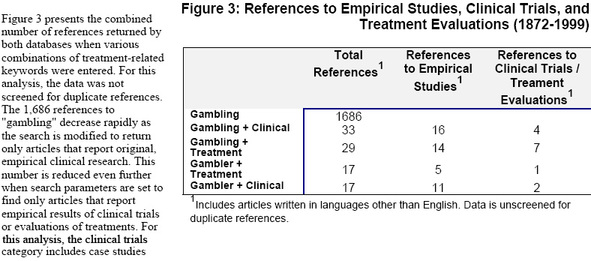Clinicians treating pathological gambling have a limited scope of therapeutic options from which to choose. Among the more popular are cognitive-behavior therapy, psychopharmacology, conventional psychotherapy, and groups based on the 12-step model. With the exception of pharmacological options, many of which are still in development, most of these treatments have been available for years. Indeed, the rate at which new treatments are developed for pathological gambling seems slow when compared with those for other disorders such as schizophrenia and depression. Such a paucity of clinical options might seem paradoxical given the vast amount of research literature produced by scholars and researchers during the past several decades. As gambling studies progresses as a topic of academic inquiry, it is important to look back and take stock of where we are and where we are going as a field.
To quantify research patterns in gambling studies, we engaged two of the literature databases most relevant to the field: Medline and PsychInfo. Both provide searchable interfaces through which over 100 years of academic journal articles can be found. Medline contains over 9.2 million records, to which 30,000 are added each month from over 3,800 medical journals from around the world. PsychInfo contains more than 1.5 million references to articles in over 1,400 psychology journals dating back to 1872. While access to PsychInfo is restricted to paying subscribers, Medline can be accessed for free through the National Library of Medicine’s Grateful Med Website. The charts below and their accompanying explanations were abstracted from multiple searches of these databases. 


That there is little published research involving treatments and therapies should not be interpreted as a reason to give up hope. A well-designed clinical trial of a new drug can take years to complete and even longer to get approved for use. Non-pharmacologic therapies require lengthy evaluations as well. A close look at figure 1 (above) reveals a marked increase in the number of gambling-related articles that begins in the late 1980s. Given the lag between the creation of a treatment and its approval and acceptance, treatments first conceived during this period might only now be ready for general use. If this trend continues, the coming years may see the clinical research efforts of the past decade finally come to fruition. However, not all new therapies are based on rigorous scientific research. Perhaps in the coming years the gap that separates research from clinical practice will be narrowed. Such is the state of gambling studies as the millenium draws to a close.
The WAGER is funded, in part, by the National Center for Responsible Gaming, the Massachusetts Department of Public Health, the Andrews Foundation, the Addiction Technology Transfer Center of New England, the Substance Abuse and Mental Health Administration Services, and the Center for Substance Abuse Treatment.




